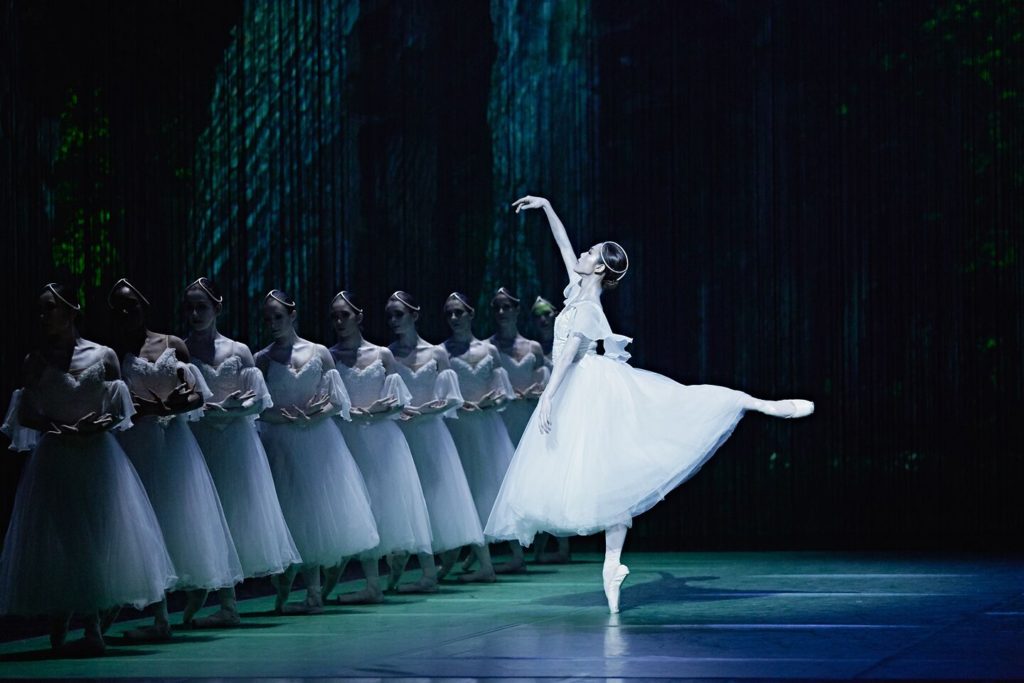Giselle – A world premiere reveals Ivan Cavallari’s contemporary vision of a 19th century ballet through the prism of ‘total art’.

The Willis featuring Yui Segawara. Photo, courtesy of the NAC.
The NAC dance programme emphasized the fact that this version of Giselle, the first for the Grands Ballets Canadiens in 20 years, respects the original choreography by Petipa based on the original narrative by French writer Théophile Gauthier who was himself an exceptional dance critic.
The opening night performance in Ottawa emphasized the narrative by foregrounding the stylish encounter of delicate and impeccably trained balletic bodies open to unexpected influences of light, and sound, of spatial transformations, of technical innovations as well as the sensuality of soft material, , swishing skirts transformed into feathery weightless objects that seemed to remove themselves from apparent romanticism bringing them closer to an exacerbated form of nightmarish symbolism. Giselle fits perfectly into this model!
The orchestra directed by Jean-Claude Picard boomed out the first moments of the overture with great energy and slightly threatening undertones, announcing joyful and graceful young peasant girls and strong young men, leaping through the air, happy to be alive, as the temperamental Hilarion (Célestin Boutin) Giselle’s friend, exhibits his explosive flights into the air, his muscular little body recalling the younger years of Nureyev when the unbelievable Bluebird with the Kirov Ballet made Parisian audiences gasp with astonishment days before the dancer defected in 1961.
In this first part of the festive country evening, Giselle (the fragile and so graceful Yui Segawara) is a shy innocent young thing who barely dares to look at the duke when he takes her hand. Little by little the festivities heat up. The dancers and the music become more passionate, Giselle moves freely with her handsome man as the shyness disappears. When the duke’s betrayal is finally confirmed, at the end of Act I, Giselle collapses with shock, her face is twisted into horror and disgust , she can barely support her own body and the performance moves to another part of the forest, the hiding place of the Willis, those frightening spirits of the dead fiancés who have been betrayed by their lovers.They wander through the forest under the control of their queen, (Maude Sabourin), waiting for their next male victim who is to be forced to dance with those strange diaphanous creatures until he collapses with exhaustion.
At that point the whole forest world is transfigured by Cavallari’s vision who shows us the world of the Willis as a projection of Giselle’s distorted mind, the fascinating modernité of his imagination that works magic on the stage until the lights are raised and the stage within the stage becomes evident at the closing moments..
This production is clearly split in two by a fin de siècle esthetic of Eros and Thanatos, life and death, death in fierce competition with each other . The temperamental Hilarion (Célestin Boutin) who flings himself about the stage in semi madness just before Giselle takes leave of her senses. He senses the coming tragedy, he tries to warn Giselle and her mother, as he literally flies over the bales of hay lying about on the ground, but is pushed aside by the aristocratic family trussed into Cavallari’s and John Dinning’s richly embroidered costumes as they refuse to give him a chance to tell what he suspects.
Yui Sugawara as a fragile, vulnerable creature flings herself to the ground and rages over the sudden discovery about her beloved Albrecht. . But her exceptional dancer’s point, her beautifully lifted legs, the swish of her delicate skirts enhanced her movements in every way, thus making her downfall even more tragic.
Act II then shows how Mark Parent’s lighting, captures glowing forms slipping between the trembling trees, that have come alive along with the brush in the background, inhabited by remarquable luminous creatures. As the Willis dance, the human visitors are enticed into the forest, where openings for symmetrical shadows appear and dissolve behind the trees. Forms suddenly materialize on the stage as they all appear and disappear from the inner depths of the forest that has become a mysteriously living creature. Such is the green mass transformed into the literal projection of Giselle’s distorted and unstable vision of the world as everything falls apart through her tortured gaze.
Yet, truly the most magnificent moments of the whole .evening were the dancing Willis, the floating deadly feathery spirits. Hopping lightly in long rows of flowing frothy material as one single body, inspite of the odd clunk from a wooden toe shoe that interrupted the atmosphere. Even the corps de Ballet at the Bolshoi has been known to produce such disturbing sounds.
Giselle’s inner struggle to save Albrecht from certain death has the two lovers intertwined in a smoothly executed pas de deux for the rest of the evening where they try to grasp each other but are unable to cling to the other body because it appears to be invisible. Albrecht can do nothing about it. However, as the Willis try to force Albrecht to keep moving even though he is exhausted and slowly dying, those final moments were extremely beautiful and sad as the impeccably delicate Yui Sugawara slithers out of the dukes grasp, slipping out of his reach. Trying at the final moment to save him, an impossible love showing she can still forgive him.. A love scene that is not a love scene, a love moment that tries to avoid bodily contact. Burning desire, frustration, all that one can hope for but that does not work..a perfect symbolist moment that would seem to forsee the unattainable, later at the end of the 19th century (Giselle was created in 1841) and that Cavallari captures very astutely in his own current modernité.
This Giselle is an event to be savoured and adored. It continues Friday(5) and Saturday (6)in Southham Hall at theNAC.